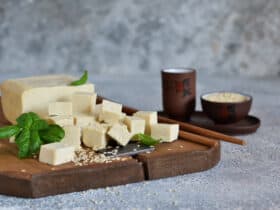We all have our favorite pasta varieties. But there’s just something about pesto pasta that makes it a global favorite for its well-balanced flavors that includes a mixture of salty, herby, and nutty. While it does have a slightly bitter flavor to it, everything just blends well together, which is why it became such a big hit.
When you look at pesto pasta, you’ll instantly notice that it has a green sauce to it, owing to the herbs that were added in its preparation. And that’s why it often begs the question: is pesto vegan? That’s what we’re here to find out.
In this article, we’ll break down the ingredients used in cooking this delicious dish. We’ll then help you determine whether it’s vegan-friendly or not.
What is Pesto?
But before anything else, let’s give you a short discussion on what pesto is.
Pesto, or more formally referred to as pesto alla Genovese, is a pasta dish using a special sauce that originated from the city of Genoa. The name “pesto” is coined from the Genoese term “pesta”, which translates to “to crush”. This is about how the sauce is originally made – by pounding all of the ingredients using a mortar and pestle.
This unique preparation process excretes all the flavorful juices from the herbs and nuts, and that’s what makes pesto incredibly good.
While pesto itself is used as a sauce that can be eaten with a variety of food, like bread or as a dipping sauce, the term is usually synonymous with pesto pasta. That is, the sauce is used along with pasta for a hearty and flavorful dish.
Another interesting fact about pesto is that it finds its origins back in the ancient Roman period. That means it’s one of the oldest food preparations out there.
But, modern pesto has transformed since its early origins, with the addition of new herbs like basil and parsley. Plus, the invention of modern tools has also made it easier and less time-consuming to prepare.
What goes into Pesto?

Now that you know what pesto is, we’re finally a step closer to determining whether it’s vegan or not. And to help you get a deeper understanding, let’s look into the ingredients that go into our favorite pasta dish.
First, let’s talk about pasta. This particular noodle is made from ground durum wheat that’s mixed with water or eggs. With that said, it may or may not be vegan, depending on whether its manufacturer used eggs in the process.
Now, let’s proceed to the sauce.
Modern pesto uses a combination of garlic, basil, pine nuts, olive oil, and parmesan cheese to create that delicious flavor. However, some people prefer swapping some of its ingredients – especially basil – with other herbs like parsley, kale, or spinach, since these are a lot easier to find.
In some instances, people also swap the pine nuts with almonds or walnuts, especially in case of allergies. Either way, you still get that unique nutty flavor from these alternatives.
Is Pesto Vegan?
Now that you know exactly what goes into pesto pasta, we can now answer the question: is pesto vegan?
Looking into its original ingredients, we can already say that pesto usually is not vegan. Here are the reasons why.
First of all, let’s discuss the sauce. While it mostly contains nuts and herbs, it also has one crucial ingredient that adds a bit of creaminess to it – parmesan cheese. Parmesan is a type of hardened cheese that comes from aged cow’s milk.
Since it is made from dairy, it only means that it is an animal by-product. As such, it can not be considered vegan-friendly.
Second, the pasta used may or may not contain eggs. If the type of pasta used for the dish has eggs in it, then it is likewise not vegan. Fortunately, most of today’s ready-to-cook pasta noodles do not contain any egg, so you can make the conscious choice whenever you’re planning to cook pesto for yourself.
> Read more: is pasta vegan?
With that said, if it weren’t for the parmesan cheese, pesto would have been safe for vegans to consume. Fortunately, there are a lot of vegan alternatives to this all-time favorite dish, so you won’t miss out on that delicious flavor. We’ll get into the details later.
Nevertheless, this is good news for our vegetarian friends. Since pesto sauce only contains milk and the pasta may only contain eggs – the absence of any animal meat means that it is perfectly safe for vegetarians to consume.
Is Sacla Pesto Vegetarian?
Earlier, we mentioned that there are vegan alternatives to pesto sauce. And when it comes to vegan-friendly sauces, the first name that comes into mind is Sacla. But the question is this: is Sacla Pesto vegetarian?
With the dedication to produce healthy plant-based alternatives to our favorite dishes, Sacla seems to have perfected its sauce game. For their vegan pesto sauce, the brand used plant-based ingredients like basil, cashew nuts, rice syrup, salt, pine kernels, spices, sunflower seed oil, and tofu. These work well together to deliver that same flavor and texture, making this sauce dairy-free.
Additionally, this sauce is free from wheat and gluten, making it the ideal choice for people with specific intolerances and allergies.
With these ingredients in mind, plus the fact that Sacla itself confirms it, we can safely say that Sacla Pesto is indeed vegetarian and vegan-friendly.
Is Pesto Gluten-Free
To answer this question, we have to look into whether we’re talking about the sauce itself or the pasta dish.
As far as the sauce is concerned, we can say that pesto is gluten-free. It does not contain any wheat derivatives, making it perfect for those suffering from gluten allergies.
On the other hand, once the sauce is added to wheat-based food like pasta and certain types of bread, it can no longer be considered gluten-free. Remember that gluten is a protein that’s often found in wheat – and since pasta is made from durum wheat, there’s no denying that it contains gluten.
Fortunately, you can find gluten-free alternatives to pasta noodles so you can still enjoy your pesto.
Vegan Pesto Recipe

To make sure that you still get to enjoy a delicious sauce, we prepared a vegan pesto recipe just for you. All you need are the following ingredients:
- Basil leaves
- Garlic
- Pine nuts
- Sea salt
- Extra virgin olive oil
- Lemon juice
- Nutritional yeast as a parmesan cheese alternative
- Water
As soon as you have all these ingredients prepared, you can now start preparing the sauce.
- The first step is to mix the basil, garlic, nuts, nutritional yeast, salt, and lemon juice.
- Once these ingredients are combined, we can now start crushing them. You can opt to do so the traditional way with a mortar and pestle, but if that’s too time-consuming, you can opt for a food processor instead. Simply set the processor to high.
- While crushing these ingredients, add a bit of olive oil and a tablespoon of water into the mix. Keep doing so once in a while until you create a paste-like texture.
- The next step is to taste the paste you have created. You can adjust it accordingly if you think it needs more salt, garlic, nutritional yeast, garlic, or lemon juice.
It’s that simple. You now have your vegan pesto sauce – perfect for your pasta, bread, or as a dip for your favorite snacks.













Leave a Reply